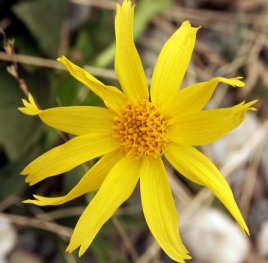Arnica Flower

| Arnica Flower in TCM:Explore the properties of Arnica Flower according to Chinese
Nutrition and Traditional Chinese Medicine (TCM):
Temperature: neutral
Channels: HT, PC
Flavors: sweet, bitter, pungent
Tonifies: qi, yin, yang
Special Properties:
circulates qi
Arnica, known as Arnica root, Common Arnica, Mountain Arnica, Mountain tobacco, Arnica flowers, Leopard's bane, and Wolf's bane, is a very popular herbal remedy that has been used for medicinal purposes since the 1500s. Arnica has been used for hundreds of years as a medicinal herb. It is said that the German poet and philosopher Goethe consumed arnica tea to relieve chest pain, but today great caution is advised when taking Arnica especially in its pure form. Its scientific name is Arnica Montana. Arnica is a perennial that grows to a height of 20–60 cm. Its stems are round and hairy, ending in one to three flower stalks.
Arnica is perhaps best known as an agent to prevent bruising, and it is also known to help bruises heal faster. Arnica has anti-bacterial and anti-inflammatory qualities that can reduce pain and swelling thereby improving wound healing time. Arnica stimulates white blood cells, stimulates blood circulation, and may raise blood pressure.
Arnica is effective herbal remedy for wounds, infections, and inflammation when applied to the skin. It can also help sunburn, acne, eczema, chapped lips, ulcers, and irritated nostrils. It may also be beneficial to those suffering from arthritis.
Arnica is available in topical creams, tinctures, ointments, and can also be used internally. It is most commonly prepared as a tincture, which can also be used as the base for compresses and poultices. Arnica is also used as a whole or cut herb, ground into a powder, used to make tea, liquid, or gel. The herb can be soaked with water and made into a poultice that is applied directly to the skin.
Arnica oil is found to have antimicrobial and anti-inflammatory properties,11 and may be helpful for treating or relieving Muscle aches, spasms, pulled muscles, or rheumatic pain. It may also aid sprains, bruises, and swelling due to fractures. It can help to soothe insect bites and stings, especially those that may lead to intense bruising and soreness. It may also help with Acne but should not be applied to broken skin. Finally some research supports the use of Arnica for hair loss when a diluted form is applied to the scalp to increase blood circulation and thus hair growth.
How to Make Arnica Oil
Materials:
- Dried and coarsely ground arnica blossoms
- Olive oil
- Mason jar
- Bottle
Procedure:
Fill the mason jar with arnica flowers and olive oil. Make sure there is enough oil to completely cover the herbs, but leave enough room for expansion.
Infuse it with a slow and steady heat for two to three weeks. You can put it in a place with sunlight or use an oven with pilot light on.
Strain the oil, and pour into a clean bottle for use.
To prolong the infused oil's shelf life, add a teaspoon of rosemary antioxidant or citric acid.
Warnings / Contraindications:
Take extreme care with dosage, as there are some evidences that when taken by mouth, it can be poisonous (in case of wrong dosage). The usage of Arnica is generally considered safe for external use. It appears to be effective for treating traumatic injury from accidents, inflammation of the mouth and throat area, and insect bites. However, prolonged use or wrong dose of oil or ointment may irritate the skin, causing eczema, peeling, blisters, or other skin conditions. Arnica should not be used on broken skin, such as leg ulcers. You could also be allergic to the components of the plant so its best to test topical application on a small part of the body first.
When taken internally Arnica can irritate the stomach and may result in vomiting, diarrhea, and nosebleeds. Arnica has caused a number of serious reactions, including allergies and at least one death.
Arnica may cause dizziness, tremors, and heart irregularities
Large doses can even be fatal.
As with any supplement you should always consult with your physician before taking Arnica, but here are some general safe dosage guidelines:
- Tincture - a 1:10 tincture prepared with 70% ethanol
- For compresses - tincture diluted 3 - 10 times with water
- As creams and ointments - 20 - 25% tincture (or a maximum of 15% arnica oil made from one part dried arnica flower head and five parts vegetable oil)
- For Poultices - tincture diluted 3 - 10 times with water
- As mouthwash - tincture diluted 10 times with water (should not be swallowed)
Disclaimer: In accordance with our terms of service, by using this web site you agree that none of the information found on this web site constitutes medical advice. You should always consult your doctor before trying any particular food or herbal remedy to treat disease.
Folk remedies presented on this site are designed to address specifc TCM diagnoses, and are not one-size-fits-all. If you would like to learn more about Traditional Chinese Medicine (TCM) and how it relates to Chinese Nutrition, you can book in a free call with a licensed professional. There is no obligation to purchase.
[CLICK HERE for your free INITIAL CONSULTATION] |
